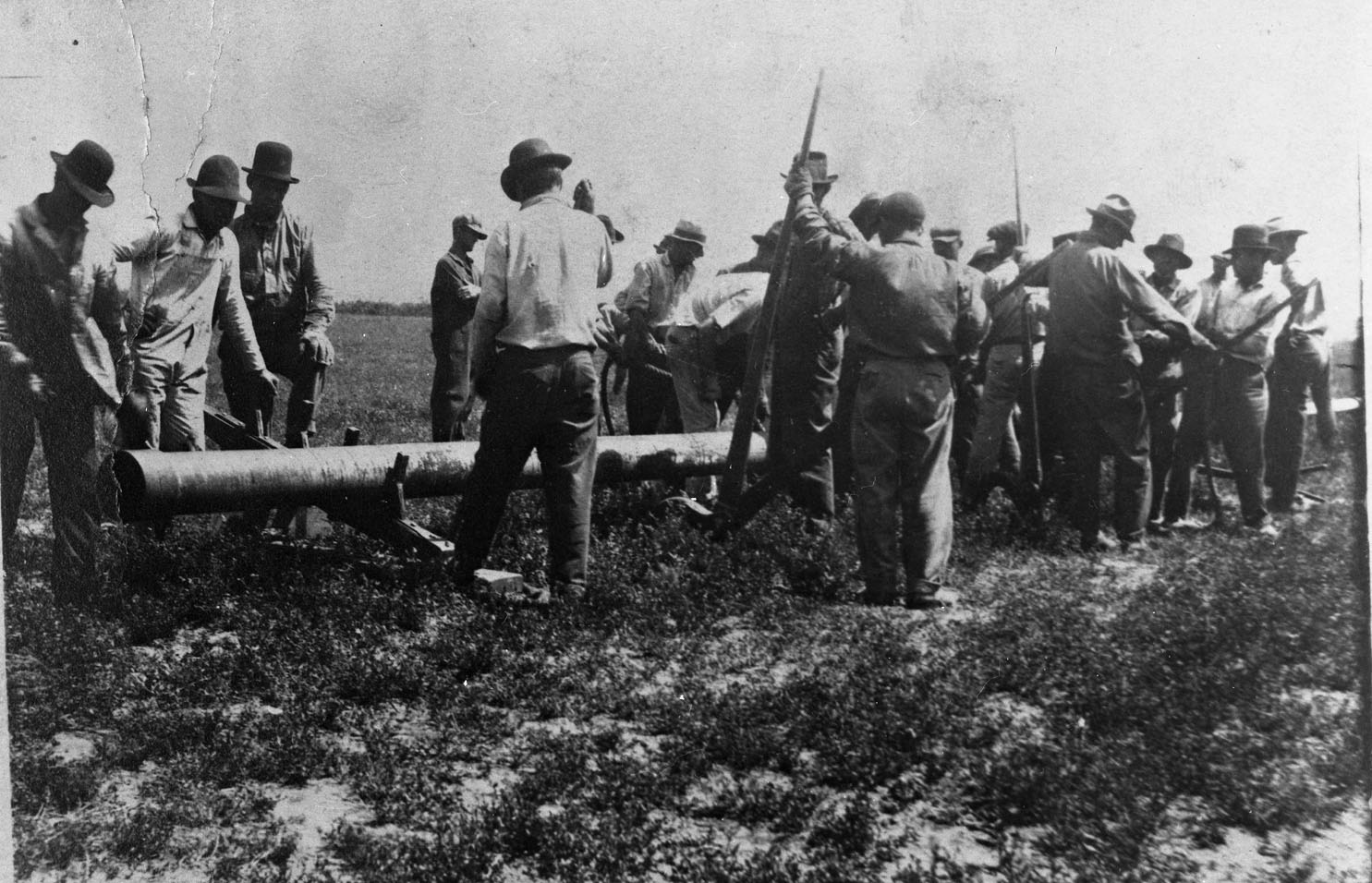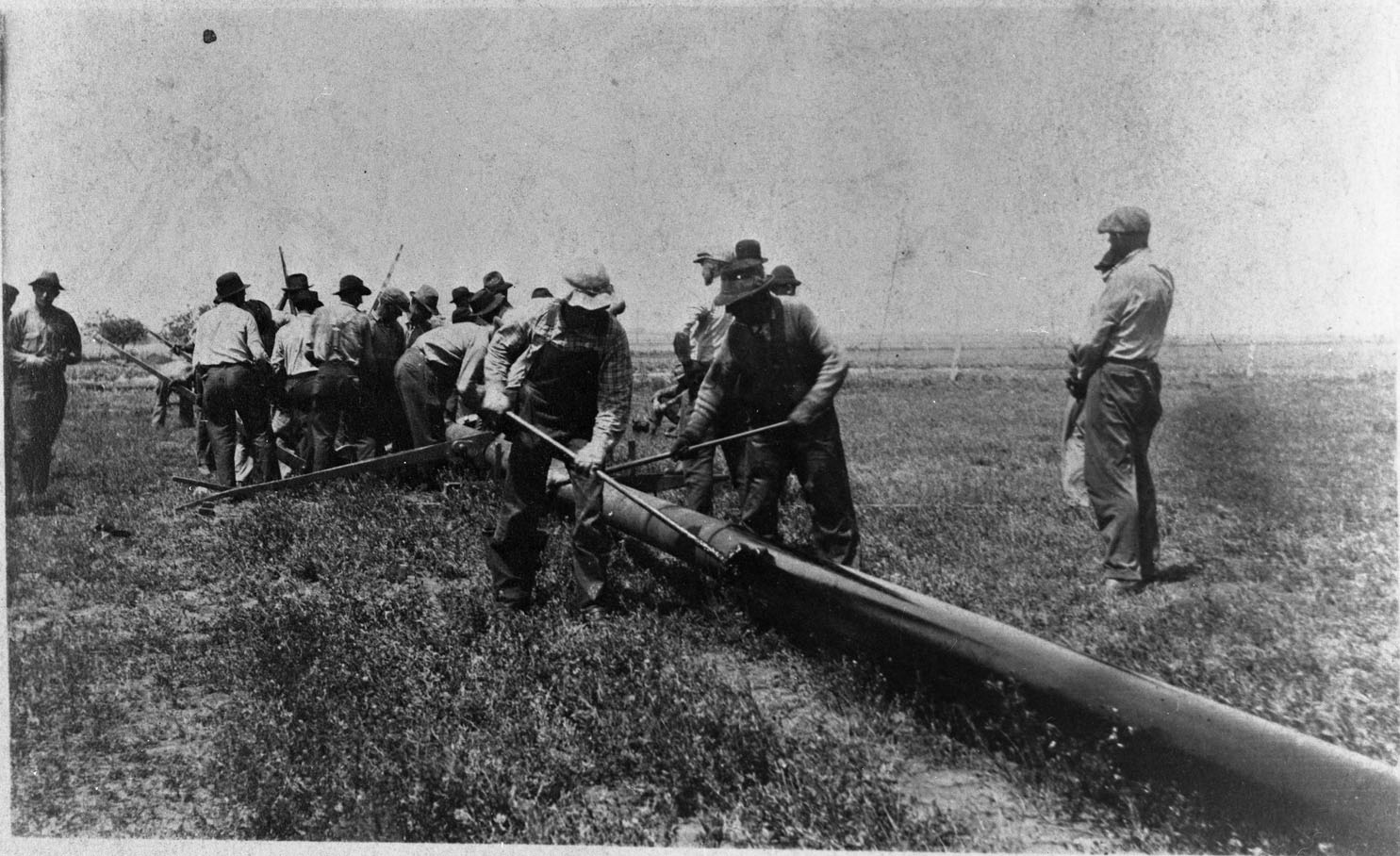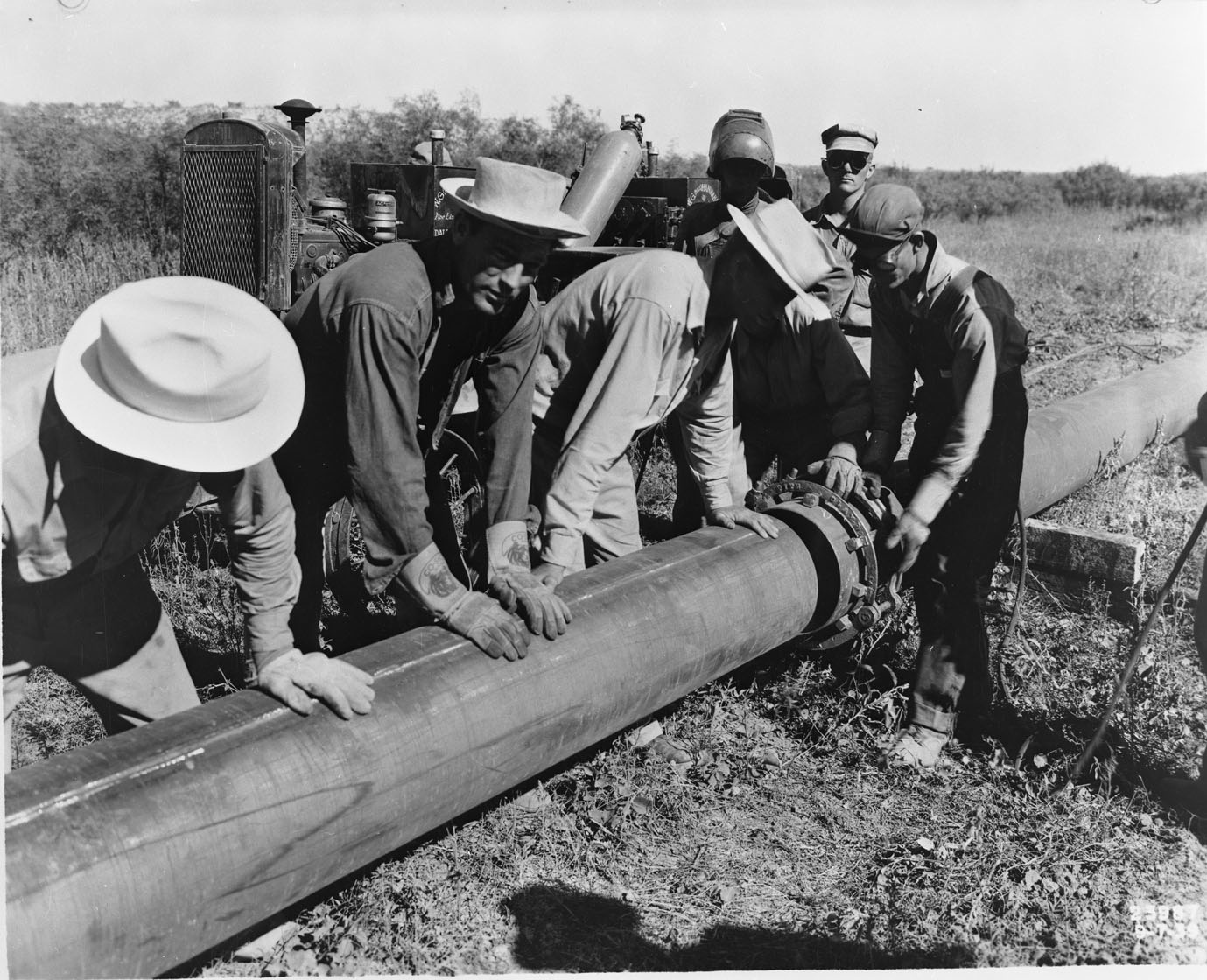They were known as “the gypsies of the oil patch.”
by Bobby Weaver
Pipeliners are the most gypsy-like of all oilfield workers. When there is a need for their services they appear like a cloud of locusts and when that need passes they are gone like a puff of smoke. It has been that way since the first oil well needed an inexpensive way to move product to market and it will remain that way until the last well is drilled. Their work is an indispensable part of the infrastructure of the oil and gas industry.
In the early days pipelining was unbelievably hard work, with everything from ditching to tightening the pipe done by hand. It attracted a cadre of workers who called themselves “cats” and they were reputed to be among the toughest hands in the oil patch, both on the job and in the beer joints. As one old cat put it:
There’s a saying in the oilfield that when a man can’t do anything else, he goes to pipelining. And there’s a lot of truth in that saying. Pipelining ain’t no picnic. Even if I do sound like I’m bragging, it takes a real man to be a pipeline cat. The work will kill an average man and lots of men have tried pipelining, but only for a spell. They can’t take it. Digging ditch all day ain’t no snap in itself, but us cats dig ditch to rest between pipeline jobs.
A major pipeline operation in those days involved several separate operations. They included survey and brush clearing, ditching, pipe stringing, line laying, and backfilling/cleanup. Burt E. Hull, legendary early day pipeliner for Texaco, described his 600 mile survey from Glenn Pool, Oklahoma, to Humble, Texas, in 1906. The survey got off to a good start when he hired a camp boss who furnished two wagons and all the sleeping and eating supplies. His job was to move camp each day and have meals ready for the surveyors each evening. All went well until in the midst of an isolated region between Sherman, Texas, and Coalgate, Oklahoma, the camp boss got lost. The surveyors had to depend on isolated farms to feed and house them for more than a week until they got to Dallas. From there to Humble the crew managed to get by without a camp. Lost camp bosses aside, getting the survey completed in a straight line was even harder given that individual county maps varied in scale, which made them hard to match up. It was many times a matter of guess work to keep the survey headed in a straight line.
Once the surveying and right-of-way clearing was done, the ditching began. It was accomplished by pick and shovel unless there were rocky outcrops that required dynamite work. Ditching was considered unskilled labor that paid in the fifteen to twenty cent per hour range. Trench size varied from place to place but it was generally about one foot wide and 18 inches deep as compared with the modern 30-inch minimum depth requirement. Ditching was also one of the few aspects of the trade that employed African Americans, who were housed in camps separate from Anglos.
Stringing the threaded pipe beside the ditch presented another specialized problem. In the case of the Glenn Pool to Humble line most of it ran parallel to the Trinity and Brazos Valley Railroad, which made getting the pipe close to the survey relatively easy. However, the actual stringing of the pipe was another question. It required an experienced man to make sure the pipe joints were unloaded close enough to each other to ensure minimal moving by the lay crews.
As soon as the pipe was strung, laying began. Laying large threaded pipe was an intricate and fast-moving process. First an inspector cleared each twenty foot joint of foreign matter, removed the thread protectors, and oiled the threads. Then 20-man carrier crews picked the pipe up and carried them with “calipers” or “carrying irons” to a precise position for tightening. At that point two tong crews operating in a leapfrog manner took over.
The tightening process began with the “stabber,” who started the threads for a four-man team, two on either side of the pipe, who looped long ropes two or three times over the pipe and in a see-saw manner “spun it in” until the connection was snug. Then the tong men, using two sets of Klein tongs generally referred to as “lay tongs,” “pipe scissors,” or “hooks,” which weighed one hundred pounds or more, took over. Each device was operated by three or four men. They tightened the pipe in a smooth, well coordinated manner, with one set of tongs going down to tighten the pipe while another was going up to get another bite. As the pipe grew tighter more sets of tong were added, up to a maximum of six. All that activity operated to the rhythm of the “collar pounder,” “tapper,” or “pecker,” depending upon the vocabulary of the crew, who used a hammer to tap a rhythm on the collar or thick part of the pipe where the pipe joins. The tapping of the collar pounder served the two-fold purpose of keeping the threads from sticking by dislodging any dirt or rust embedded in them and setting the pace at which the tongs operated.
The average pipe laying crew consisted of approximately 100 men. They worked 10- or 12-hour days, allowing them to connect about 175 joints of 20-foot pipe or about three-quarters of a mile per day. Because the lay crew’s work was considered more skilled in those days, they were paid 25 to 30 cents per hour. With the pipe assembly done another crew raised the tightened pipe and lowered it into the hole by means of a hand operated wooden windlass or on rare occasion by draft animals. That was usually done as early in the day as possible when the pipe was cool and had contracted to its shortest length. Even then the pipe was laid in the trench with as much side-to-side variation as possible to allow for heat changes that could stretch the pipe and cause it to break.
With the pipe in the ground the backfill crew filled the ditch. They used either Fresno scrapers or “marmon boards” which were simply boards about five feet long with ropes attached at each end so that mules could pull them and drag the dirt into the ditch. Afterward the backfill crew smoothed and cleaned up the right-of-way.
The work of laying a large line took crews numbering in the hundreds. They lived in tent camps consisting of ten or more tents housing ten men each. The ditching camp was usually four or five miles ahead of the laying camp and the men of any of these camps—ditching, laying, backfilling—walked to work each day until the completed ditch was about as far ahead of the camp as it once had been behind the camp. Then the camps were moved, which allowed them to stay in one place a week or ten days. Thus the ditching camp, the laying camp, and the backfilling camp moved forward at a steady pace.
Those basic steps are the way pipelining has remained to the present, although mechanization and welding has greatly speeded up the process and made it much more efficient.
The last large threaded pipeline job in Texas took place in 1927, when the Gulf Oil Corporation built a 546-mile combination eight- and ten-inch line from Crane in the Permian Basin to Lufkin in Southeast Texas. That job employed mechanical ditching, laying, and backfilling equipment that increased its speed to four and one-half miles per day as opposed to the earlier three quarters a mile rate. Nevertheless, the job required six gangs of 150 to 200 men each who lived in portable tent camps pretty much like those of 20 years earlier.
By the time the Crane to Lufkin job was completed, welding was coming into vogue. In 1925 the Magnolia Gas Company completed the first major acetylene welded pipeline using 14-, 16-, and 18-inch pipe on its 217-mile line from northeast Texas to Beaumont, which made acetylene welding the accepted process for the next several years. By the early 1930s, however, acetylene welding gave way to the newly invented electric welding process. That along with the introduction of seamless pipe and improved mechanical equipment heralded significant changes in the pipelining trade for the rest of the century.
The many changes experienced by pipelining during the mid-1930s reduced the industry’s labor needs by approximately 75 percent. Ditching was done by machine, requiring minimal labor beyond a trained operator. Connecting pipe was done by welders, which was a skilled trade that mandated considerable training and eliminated large numbers of unskilled workers. Laying the line was also done by machine, which reduced that work force by 50 percent. And finally the backfill work was done by machine, which required a trained operator assisted by minimal unskilled labor. Thus, by the period of World War II, pipelining had experienced significant technological change—so much so that the hordes of workers who once followed that trade were greatly reduced, becoming a core of trained professionals with specific specialties. That process has continued to the present, utilizing pipeliners who must pass stringent testing to be licensed to do specific jobs such as welding.
Nevertheless all that technological change has not affected the gypsy-like nature of the profession. Pipeliners do not tend to congregate in specific locations between jobs. They might live anywhere, but when the call goes out for hands to work on a new pipeline they appear. The days of tent camps housing hundreds of men is a thing of the past. Maybe on large isolated jobs like the trans-Alaska line back in the 1970s there would be semi-portable living quarters, but for the most part the pipeliners of today stay at motels or follow the job in the relative comfort of their modern campers. However, regardless of the manner of their day-to-day living, to outsiders watching from afar they still appear to descend upon an area like a cloud of locusts when needed and disappear like a puff of smoke when the job is done.
Bobby Weaver is a regular contributor to PBOG Magazine. His humor column, “Oil Patch Tales,” appears in this issue.












